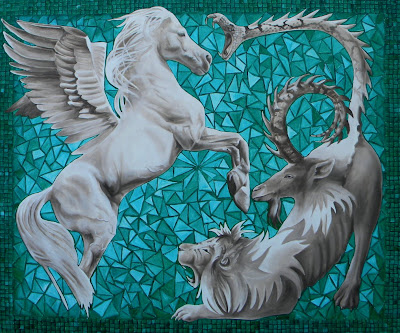
oil on canvas 120 x 100 cm
€ 3.000,00
In the city of Corinth, Glaucus is King. But the gods dislike him because he feeds his horses human flesh. Eventually the gods throw him from his chariot and have his horses eat him. It is thought that Glaucus's son is a beautiful young man named Bellerophon, but it is also rumored that the boy's father is Poseidon. More than anything, Bellerophon wants to ride Pegasus, a winged horse, so he goes to Athena's temple to pray. Athena comes to him in a dream and gives him a golden bridle which, she says, will tame the horse. It does, and Pegasus becomes Bellerophon's loyal beast.
Later, Bellerophon kills his brother entirely by accident. He goes to King Proteus for purification, which the king grants. But Bellerophon's situation becomes complicated when the king's wife takes an interest in him. Bellerophon denies the queen's advances, but the evil woman tells her husband that the boy has wronged her and must die. Proteus does not want to kill Bellerophon personally because the boy has eaten at his table, so instead he asks the boy to deliver a letter to the Lycian king.
On the back of Pegasus, Bellerophon travels easily, meets the Lycian king, and stays with him for nine wonderful days. When the king opens his letter, it has clear instructions to kill Bellerophon. But like Proteus, the Lycian king does not want to offend Zeus by acting violently towards a guest, so instead he sends Bellerophon on an impossible journey to kill a monster, Chimaera. With the help of Pegasus, however, Bellerophon kills the beast with no harm to himself. He returns to Proteus, and Proteus sends him on many more challenging adventures.
Eventually, the victorious Bellerophon wins Proteus's respect, and the king even gives the man his daughter's hand in marriage. Unfortunately, Bellerophon loses favor with the gods when he attempts to become more than human and take a place on Mount Olympus. When he tries to take the journey up to the gods’ kingdom, Pegasus throws Bellerophon off his back. Bellerophon wanders alone, "devouring his own soul," until he dies. Pegasus becomes Zeus's favorite animal, residing in the stalls of Mount Olympus and bringing thunder and lightning to him.
source: Edith Hamilton,
Mythology
ed. GradeSaver


